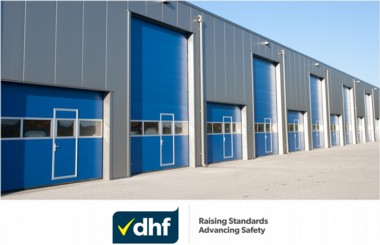
With regards to safety brakes and the law, Training and Compliance Officer, Nick Perkins, provides clarity on this common theme. And in particular, is it a legal requirement for a vertically acting door to have a safety brake?
 “This is the most common question asked of the DHF technical team and the answer might surprise you,” explains Nick.
“This is the most common question asked of the DHF technical team and the answer might surprise you,” explains Nick.
The truth is that there has never been a legal requirement, law or standard requiring the use of a safety brake or any other fall-back protection device, and this remains the case. Notwithstanding, this is far from ‘black and white’ as a very real legal requirement exists to prevent falling-back (guillotining shut) when a vertically acting door’s hold-open system suffers a failure.
“It has always been necessary to prevent such devastating and potentially fatal incidents,” says Nick.
Legislation does exist that has had a significant impact on this requirement. This includes, for example, the GB Health and Safety at Work Act 1974, the NI Health and Safety at Work Order 1978 and the ROI Safety, Health and Welfare at Work Act 2005, all of which cover a general requirement to ensure safety at work, whilst working, and as a result of work. They place a criminal responsibility on manufacturing, installation, maintenance, and owner/manager operations and are most commonly used to prosecute when fall-back incidents occur.
In addition, the UK Workplace (Health Safety & Welfare) Regulations 1992, the NI Workplace (Health Safety & Welfare) Regulations 1993 and the ROI Safety, Health and Welfare at Work (General Applications) Act 2007 all place a criminal responsibility on owners and managers of workplaces to ensure that vertically acting doors are protected from falling back. And the UK Supply of Machinery (Safety) Regulations and the EU Machinery Directive have also been in force since 1995, requiring powered door manufacturers to ensure that potentially harmful uncontrolled movements are prevented.
"Since 2013, industrial and garage door manufacturers have had to comply with the UK Construction Products Regulations or the EU Construction Products Regulation. Although these did not change safety requirements, they did require manufacturers to have fall-back protection type testing completed by government-approved (notified) conformity assessment bodies,” says Nick.
“British and European standards, which provide guidance on compliance with the law, were first published in 2000,” he continues. “EN 12453 covers powered doors and EN 12604 covers manual doors. These standards have changed very little in the past 23 years and describe, in detail, how protection should be achieved. The door should either weigh no more than 20kg, or not fall more than 300mm and be prevented from further use, if there is a fault with any one spring, cable, strap, chain, drive gear, gearbox, or hydraulic component in the hold open system.”
Whilst a rolling shutter door without spring balancing obviously needs a safety brake or internally protected direct drive if it weighs more than 20kg, assessing other spring balanced shutter, sectional and retractable doors can be a much more complex and challenging process. Protection can be achieved with devices, by inherently safe design, or a combination of both.

“DHF run regular fall-back protection webinars for members and this subject is explained in detail by DHF TS 013, part 1 on-site guide. Fall back protection is also central to our industrial and garage door training courses,” concludes Nick.
For further information, please visit: http://bit.ly/2SgfGmT
10th April 2023
Join dhf
Enjoy the full benefits of dhf membership
Apply today